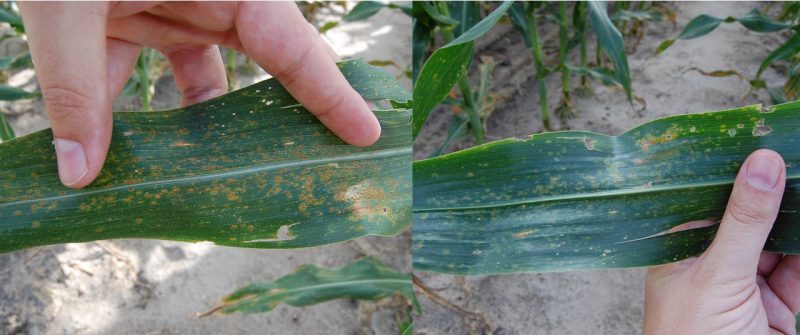Dr. Nick Dufault, UF/IFAS Plant Pathologist; Dr. Ian Small, UF/IFAS Plant Pathologist; Ethan Carter, UF/IFAS Extension Regional Specialized Agent Row Crop IPM; Dr. Bob Kemerait, UGA Plant Pathologist
Southern rust has once again been confirmed in Panhandle corn fields, just as many March-planted fields reach tassel stage (VT). The window from tassel to milk stage (R3) is critical for protecting yield.

Typical southern rust signs above: orange to light brown, small and densely packed pustules on the upper leaf surface (left). The lower leaf surface (right) has yellow flecks and very few if any pustules. These symptoms and signs can distinguish southern rust from common rust.
–
Southern rust can cause up to 45% yield loss in severe cases. Timely fungicide applications between R1 and R3 typically preserves 5–10 bu/A, with untreated early infections potentially costing up to 100 bu/A, according to Dr. Bob Kemerait, UGA Extension’s Plant Pathologist . Depending on disease pressure and crop use (grain vs. silage), additional applications may be needed. Fungicides applied within two weeks of black layer (physiological maturity) are not likely to provide a return on investment even if they provide adequate disease control.
Growers are encouraged to scout actively and consult the Corn Disease Working Group’s Fungicide Efficacy Chart (see page 2) to compare product options. Mixed-mode-of-action products generally offer longer protection and reduce resistance risk.
Scout now and act early to protect your yields. For additional information about Southern Corn Rust, use the following link for the Southern Crop Protection Network’s Southern Corn Rust Disease Management Guide. For other information, contact your local extension office.
- 2025 End-of-Season Florida Peanut Disease Notes - October 24, 2025
- Southern Rust Confirmed in the Florida Panhandle – June 2025 - June 6, 2025
- Stay Ahead of Disease with the Spore Report: A New Tool to Assist with Potato and Watermelon Management - April 11, 2025
